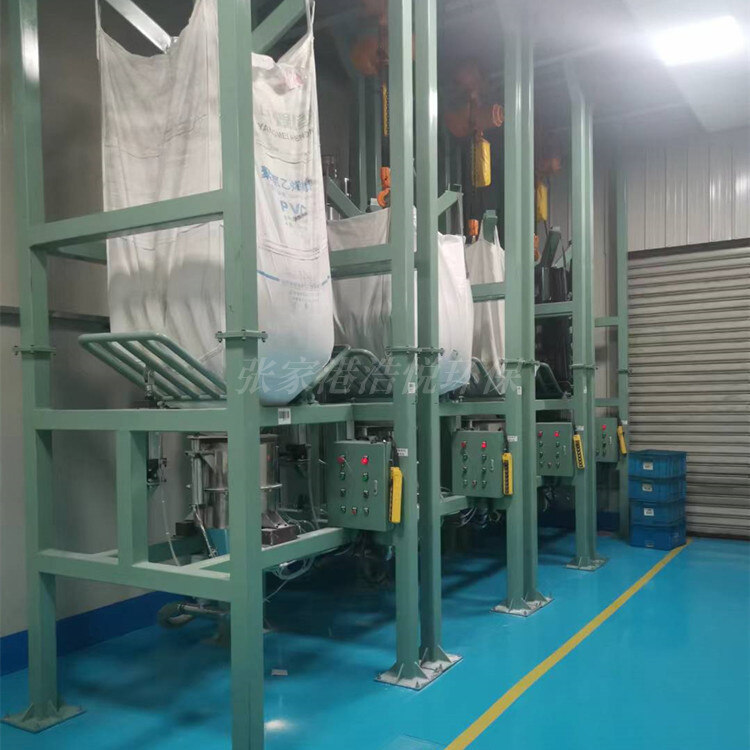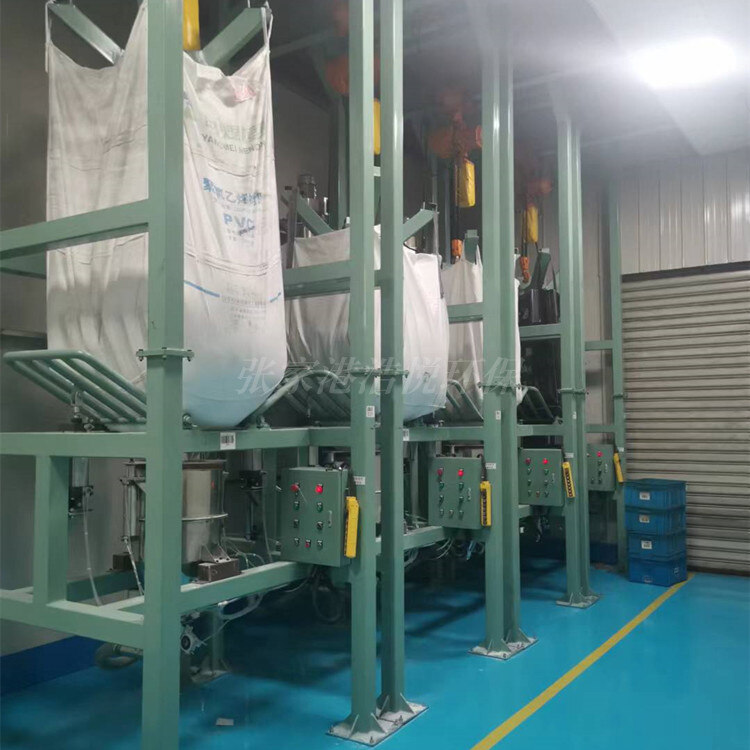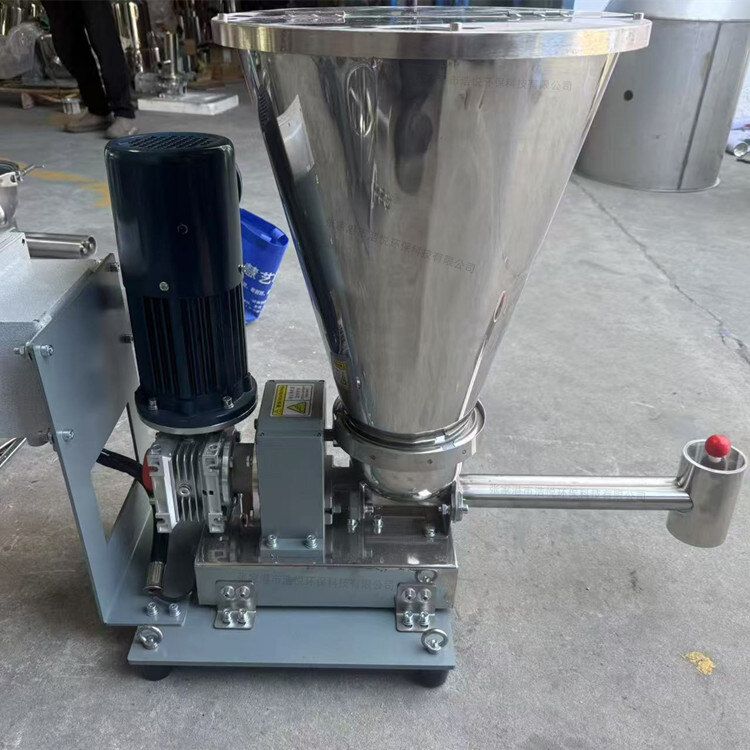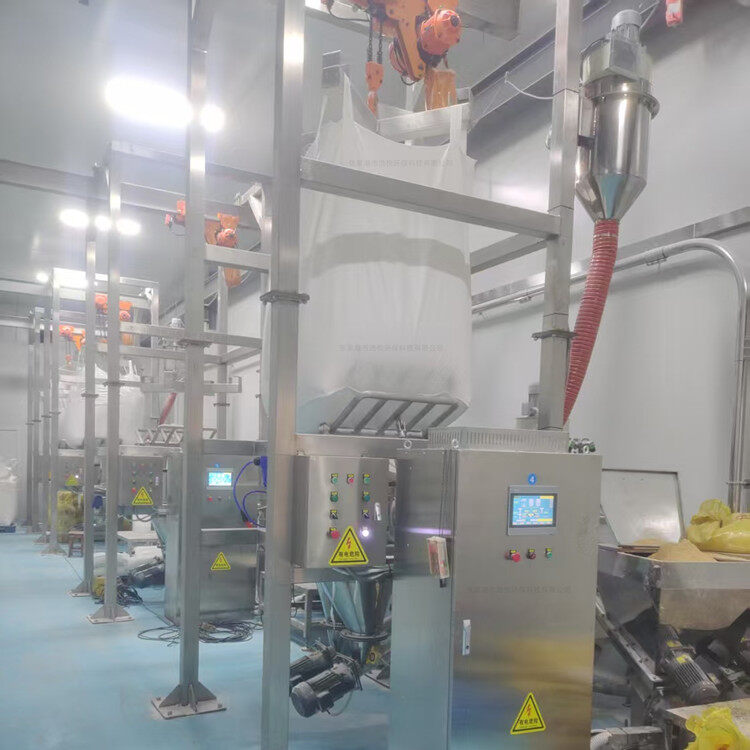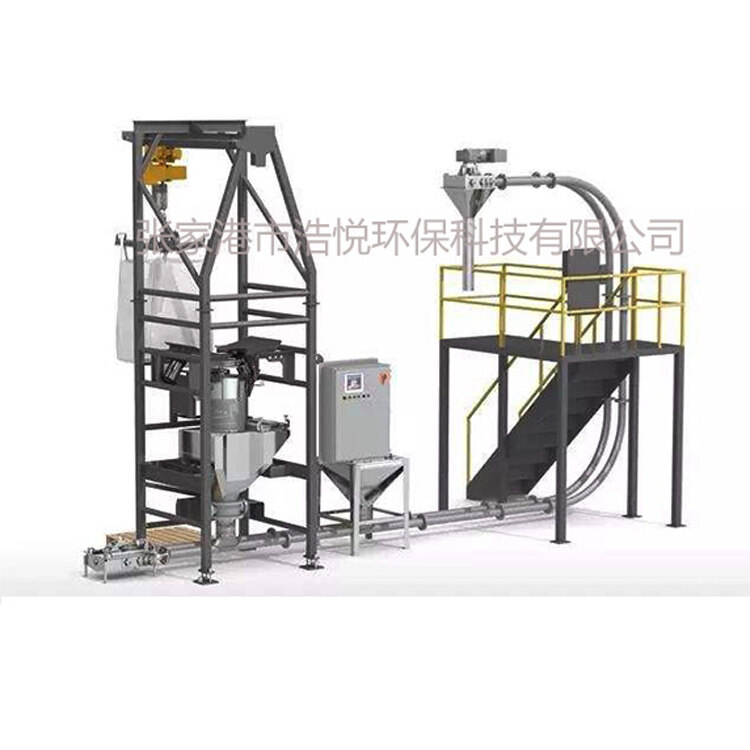- Introduction to automatic batching machine and fully automatic batching machine equipment
- The powder metering system tells you about the introduction of the mixing and drying machine
- 1000kg vacuum feeding machine
- Fully automatic small material batching system
- Research on Innovation of Automatic Weighing Machine Technology
- Design and operation of automatic batching system using PLC, industrial computer and frequency converter
Ton bag packaging machine
- Category:Ton bag unloading station
- Hits:210次
- Release Date:2025-06-30
- Share:
- Inquiry
- Details
Introduction to ton bag packaging machine
In the process of industrial production moving towards scale and automation, the ton bag packaging machine, as the core equipment for bulk material packaging, plays a key role in industries such as chemical, building materials, food, and mining with its efficient, precise, and intelligent packaging capabilities. This equipment, specifically designed for ton level large bag packaging, integrates functions such as weighing and measuring, automatic feeding, sealing and sewing to achieve standardized packaging of materials ranging from 250kg to 2000kg, effectively improving production efficiency and reducing labor intensity. The following will comprehensively analyze the ton bag packaging machine from the aspects of equipment composition, working principle, technological advantages, application scenarios, and development trends.
1、 Equipment core composition architecture
The ton bag packaging machine is mainly composed of six modules: weighing and measuring unit, feeding system, bag frame and lifting mechanism, sealing device, control system, and auxiliary unit. Each part works together to form a complete automated packaging system.
(1) Weighing and measuring unit
The weighing and measuring unit is the core module of the ton bag packaging machine, which determines the packaging accuracy and stability. High precision weighing sensors (with a range of 500-3000kg and an accuracy of ± 0.2% - ± 0.5%) are usually used in combination with a weighing platform. The platform surface is paved with anti slip patterns or grid plates to prevent the ton bag from sliding. According to the characteristics of different materials, the measurement methods are divided into:
Gravity based metering: suitable for granular materials with good fluidity (such as grains and plastic particles), which are directly fed into ton bags through the discharge port of the silo. The weight sensor provides real-time feedback on the weight, and the discharge valve is closed when the set value is reached.
Spiral metering: For powdered materials such as cement and carbon black, a spiral feeder is used to control the feeding speed. The material is quickly filled to 90% of the target weight, and then slowly replenished to the precise value to avoid dust and improve accuracy.
Weight loss measurement: used for valuable or high-precision materials (such as catalysts, pharmaceutical raw materials), by monitoring the weight changes of the silo in real time and controlling the feeding amount with PLC algorithm, the accuracy can reach ± 0.1%.
(2) Loading system
The feeding system is responsible for transporting materials from the storage bin to the packaging station, and selecting different conveying methods according to the material form:
Pneumatic conveying: For powdered materials, air flow is formed in the pipeline through vacuum or compressed air, and the materials are conveyed to the top hopper of the packaging machine. The conveying distance can reach 50 meters and is sealed without dust.
Belt/chain plate conveying: suitable for granular materials, lifted to the hopper through conveying equipment, with a flow rate of up to 10-50 tons/hour.
Forklift/crane loading: For block or large particle materials, manual or mechanical handling is used to transport the materials to the hopper, and the vibrating feeder is used to evenly discharge the materials.
(3) Bag rack and lifting mechanism
The bag rack is used to secure ton bags, usually using a gantry or cantilever structure, equipped with pneumatic or electric clamping devices to ensure the stability of the ton bags during the packaging process. The lifting mechanism is driven by a servo motor or hydraulic system, which can achieve precise positioning of the ton bag
Automatic bagging: The position of the ton bag is detected by a photoelectric sensor, and the bag mouth is fitted into the discharge port by a mechanical arm or pneumatic device. A sealing rubber ring is used to prevent dust leakage.
Weighing platform lifting: After packaging is completed, the lifting mechanism lifts the ton bag off the platform for easy forklift transportation. Some high-end models are equipped with electronic scale anti shake devices to avoid shaking during weighing and affecting accuracy.
(4) Sealing device
Sealing devices are divided into various forms based on the material of the ton bag and the usage scenario:
Stitching and sealing: Using an industrial sewing machine, for polypropylene (PP) ton bags, double line stitching is used to ensure the strength of the bag opening, with a sewing speed of up to 20 meters per minute.
Heat sealing: Suitable for polyethylene (PE) ton bags, the bag opening film is melted by a heating plate and then bonded by a pressure roller, with excellent sealing effect and good leak proof performance.
Cable tie sealing: For scenarios that require quick sealing, a pneumatic cable tie machine is used to fix the bag opening with plastic cable ties, which is easy to operate and suitable for temporary packaging.
(5) Control system
Using PLC (Programmable Logic Controller) as the core, paired with a 10-15 inch touch screen human-machine interface (HMI), supporting multilingual operations. The operator can set:
Packaging parameters: target weight, cutting speed, sealing mode, etc., supporting the storage of more than 50 sets of formulas and quick switching between different material packaging.
Operation monitoring: Real time display of current weight, cumulative packaging quantity, equipment status (such as motor temperature, air pressure value), automatic alarm in case of abnormalities (such as overweight, underweight, material blockage).
Data management: Generate production reports, record the weight of each bag, packaging time, operator information, etc., support USB export or online upload to MES system.
(6) Auxiliary unit
The auxiliary unit includes a dust removal system, an automatic bagging device, and safety protection equipment
Dust removal system: Dust collection ports are installed in the hopper and discharge port, combined with bag filters, with a dust removal efficiency of ≥ 99%, ensuring that the workshop dust concentration is ≤ 10mg/m ³.
Automatic bagging device: High end models are equipped with mechanical arms or conveyor belts to achieve automatic picking, spreading, and bagging of ton bags, reducing manual intervention and improving automation.
Safety protection: emergency stop button, overload protection, safety light curtain (to prevent accidental contact by personnel), and explosion-proof design (applicable to flammable and explosive materials).
2、 Working principle and process
The workflow of the ton bag packaging machine follows the closed-loop logic of "bagging metering filling sealing unloading":
Bagging and positioning: Manually or mechanically place the ton bag on the bag rack, clamp the bag opening with a pneumatic fixture, and confirm the correct position of the bag opening with a photoelectric sensor.
Automatic metering and filling: The feeding system transports the material to the hopper. According to the preset weight, the discharge valve opens quickly. When the weight reaches 80% -90% of the target value, it switches to slow feeding until the set weight is reached. The weighing sensor provides real-time feedback and controls the discharge valve to close.
Sealing treatment: Choose sewing, heat sealing, or zip sealing according to the material of the ton bag, and the sealing device automatically completes the operation to ensure that the bag mouth is sealed firmly.
Unloading and transportation: The lifting mechanism lifts the packaged ton bags, releases the fixtures, and transports them to the designated area by forklift or crane. At the same time, the system automatically resets to zero and prepares for the next packaging.
Taking the packaging of 50kg cement ton bags as an example, the entire process from bagging to unloading takes about 1-2 minutes, and the single machine production capacity can reach 30-60 bags/hour, which is 5-10 times more efficient than manual packaging.
3、 Core technological advantages
(1) High precision measurement and stable packaging
By using imported weighing sensors and dynamic compensation algorithms, a measurement accuracy of ± 0.5% can be guaranteed even in vibration environments. After a certain chemical enterprise used a ton bag packaging machine, the material packaging error decreased from ± 3% in manual operation to ± 0.3%, reducing material waste by more than 50 tons per year.
(2) Efficient Automated Homework
The entire process from bag delivery, bagging, measurement to sealing is automated, reducing manual intervention and labor intensity. Models equipped with automatic bagging devices can achieve 24-hour unmanned operation, suitable for large-scale production scenarios.
(3) Flexible production adaptation
Supports full range packaging of 250-2000kg, and can quickly switch between different specifications of ton bags by changing fixtures and adjusting parameters. For multi variety and small batch production, the formula storage function can achieve changeover within 10 minutes to meet personalized packaging needs.
(4) Intelligent management and traceability
Integrated IoT module, capable of remote monitoring of device operation status, fault warning, and automatic uploading of production data to the cloud, facilitating production capacity analysis, cost accounting, and quality traceability for enterprises. A certain building materials group has managed 10 ton bag packaging machines through networking, resulting in a 15% increase in equipment OEE (overall efficiency) and a 20% reduction in maintenance costs.
4、 Application scenarios
(1) Chemical industry
Used for packaging bulk chemical raw materials such as fertilizers, resins, plastic particles, etc., such as urea, polyethylene particles, polypropylene powder, etc. The weight of a single bag is usually 500-1500kg, requiring fast packaging speed and leak prevention. After adopting a ton bag packaging machine, the packaging efficiency of a certain phosphate fertilizer plant increased from 80 tons/shift to 150 tons/shift, while reducing dust emissions by 70%.
(2) Building materials industry
The packaging of powdered materials such as cement, fly ash, and dry mixed mortar often uses a specification of 250-1000kg, requiring the packaging machine to have dust resistance and wear resistance. At the commodity concrete mixing plant, the ton bag packaging machine is connected to the bulk cement tanker to achieve efficient transportation of materials.
(3) Food and Grain Industry
The packaging of granular materials such as grains (such as wheat, corn), feed, sugar, etc. should pay attention to hygiene standards and pest control design. The part of the packaging machine that comes into contact with the material is made of 304 stainless steel, with a polished surface that meets food grade requirements. Some models are also equipped with metal detection function to prevent impurities from entering.
(4) Mineral and metallurgical industry
The packaging of heavy industry materials such as ore powder, coal powder, and metallurgical auxiliary materials requires equipment to be wear-resistant and impact resistant. A certain iron ore powder processing plant uses an explosion-proof ton bag packaging machine, combined with a dust removal system, to solve the dust and explosion hazards during the iron powder packaging process.
5、 Development Trends
(1) Intelligence and unmanned
Introducing AI vision system to automatically detect ton bag damage and sealing quality, combined with robots to achieve unmanned operation throughout the entire process. For example, robotic arms can automatically load bags and AI algorithms can optimize the cutting curve, further improving packaging accuracy and speed.
(2) Green and energy-saving
Develop low-energy servo motors and energy recovery systems, while optimizing dust removal design and using self-cleaning filters to reduce replacement frequency. The energy-saving ton bag packaging machine developed by a certain enterprise has reduced energy consumption by 35% compared to traditional models and extended filter life by 2 times.
(3) Modularization and customization
Develop detachable explosion-proof modules and fully sealed isolation packaging units for special materials such as radioactive substances and highly toxic chemicals to meet the needs of high-risk scenarios. At the same time, provide API interfaces for deep integration with enterprise ERP systems to achieve real-time sharing of packaging data.
From traditional manual bag sewing to intelligent unmanned packaging, the technological innovation of ton bag packaging machines has always revolved around the three core values of "efficiency, accuracy, and safety". In the future, with the advancement of Industry 4.0, the ton bag packaging machine will not only be a packaging equipment, but also a key node connecting material storage and logistics transportation in smart factories, promoting the digitization, networking, and intelligence of bulk material packaging.


